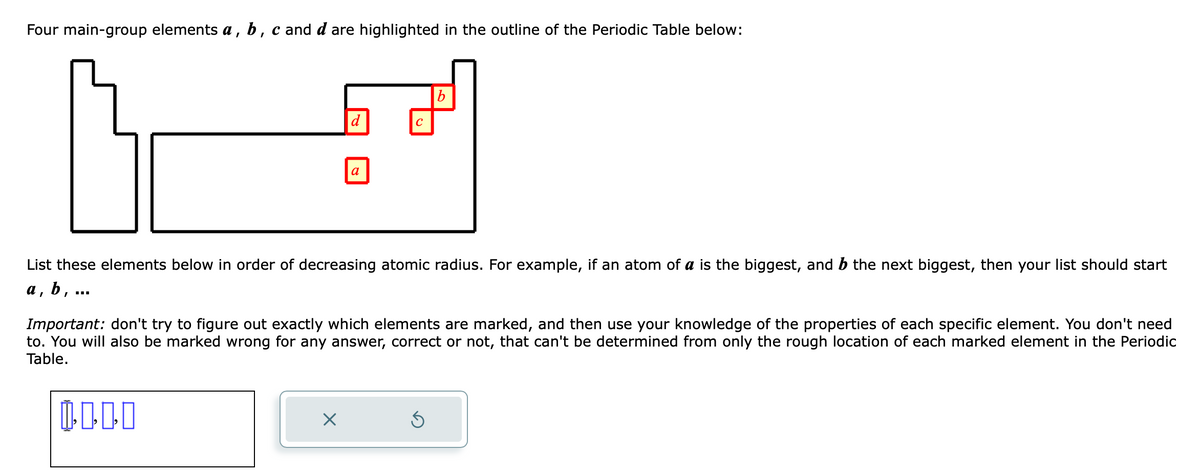Four main-group elements a, b, c and d are highlighted in the outline of the Periodic Table below: d a List these elements below in order of decreasing atomic radius. For example, if an atom of a is the biggest, and b the next biggest, then your list should start a, b, ... X Important: don't try to figure out exactly which elements are marked, and then use your knowledge of the properties of each specific element. You don't need to. You will also be marked wrong for any answer, correct or not, that can't be determined from only the rough location of each marked element in the Periodic Table. 0000
Four main-group elements a, b, c and d are highlighted in the outline of the Periodic Table below: d a List these elements below in order of decreasing atomic radius. For example, if an atom of a is the biggest, and b the next biggest, then your list should start a, b, ... X Important: don't try to figure out exactly which elements are marked, and then use your knowledge of the properties of each specific element. You don't need to. You will also be marked wrong for any answer, correct or not, that can't be determined from only the rough location of each marked element in the Periodic Table. 0000
Principles of Modern Chemistry
8th Edition
ISBN:9781305079113
Author:David W. Oxtoby, H. Pat Gillis, Laurie J. Butler
Publisher:David W. Oxtoby, H. Pat Gillis, Laurie J. Butler
Chapter5: Quantum Mechanics And Atomic Structure
Section: Chapter Questions
Problem 37P: The first ionization energy of helium is 2370kJmol1 , the highest for any element. (a) Define...
Related questions
Question

Transcribed Image Text:Four main-group elements a, b, c and d are highlighted in the outline of the Periodic Table below:
List these elements below in order of decreasing atomic radius. For example, if an atom of a is the biggest, and b the next biggest, then your list should start
b, ...
a
d
X
a
с
Important: don't try to figure out exactly which elements are marked, and then use your knowledge of the properties of each specific element. You don't need
to. You will also be marked wrong for any answer, correct or not, that can't be determined from only the rough location of each marked element in the Periodic
Table.
0.000
b
S
Expert Solution
This question has been solved!
Explore an expertly crafted, step-by-step solution for a thorough understanding of key concepts.
This is a popular solution!
Trending now
This is a popular solution!
Step by step
Solved in 4 steps

Knowledge Booster
Learn more about
Need a deep-dive on the concept behind this application? Look no further. Learn more about this topic, chemistry and related others by exploring similar questions and additional content below.Recommended textbooks for you

Principles of Modern Chemistry
Chemistry
ISBN:
9781305079113
Author:
David W. Oxtoby, H. Pat Gillis, Laurie J. Butler
Publisher:
Cengage Learning

Introductory Chemistry: An Active Learning Approa…
Chemistry
ISBN:
9781305079250
Author:
Mark S. Cracolice, Ed Peters
Publisher:
Cengage Learning

World of Chemistry, 3rd edition
Chemistry
ISBN:
9781133109655
Author:
Steven S. Zumdahl, Susan L. Zumdahl, Donald J. DeCoste
Publisher:
Brooks / Cole / Cengage Learning

Principles of Modern Chemistry
Chemistry
ISBN:
9781305079113
Author:
David W. Oxtoby, H. Pat Gillis, Laurie J. Butler
Publisher:
Cengage Learning

Introductory Chemistry: An Active Learning Approa…
Chemistry
ISBN:
9781305079250
Author:
Mark S. Cracolice, Ed Peters
Publisher:
Cengage Learning

World of Chemistry, 3rd edition
Chemistry
ISBN:
9781133109655
Author:
Steven S. Zumdahl, Susan L. Zumdahl, Donald J. DeCoste
Publisher:
Brooks / Cole / Cengage Learning

Chemistry for Today: General, Organic, and Bioche…
Chemistry
ISBN:
9781305960060
Author:
Spencer L. Seager, Michael R. Slabaugh, Maren S. Hansen
Publisher:
Cengage Learning

Chemistry: The Molecular Science
Chemistry
ISBN:
9781285199047
Author:
John W. Moore, Conrad L. Stanitski
Publisher:
Cengage Learning

Introductory Chemistry: A Foundation
Chemistry
ISBN:
9781337399425
Author:
Steven S. Zumdahl, Donald J. DeCoste
Publisher:
Cengage Learning